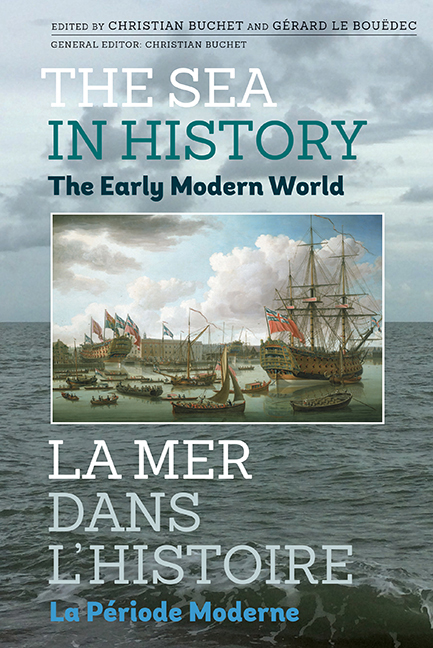Book contents
- Frontmatter
- Contents
- List of Illustrations
- List of Contributors
- Introduction générale et remerciements par
- General introduction and acknowledgements
- Introduction (français)
- Introduction (English)
- LA RÉUSSITE PAR LA MER:La reussite par la mer des territoires et des communautés littorales
- La construction d'un espace mondial: La circulation maritime et les ports
- Les dynamiques des circulations maritimes au XVIIIe siècle entre paix et guerre: ports, circuits, flottes entre logiques étatiques et logiques marchandes
- The European seaport system at the beginning of the early modern age
- Port location and development in the British Atlantic World in the seventeenth and eighteenth centuries
- Mutations et recompositions des flottes marchandes en Méditerranée
- Indian ports and European powers
- African Atlantic ports and trade fleets
- Les ports du Maghreb à l'époque moderne
- La forte croissance de l'économie des pêches et des échanges
- Les acteurs de la dynamique maritime
- LA PUISSANCE MARITIME INSTRUMENT DE LA PUISSANCE POLITIQUE ET D'UNE STRATÉGIE GLOBALE DE RAYONNEMENT VOIRE DE DOMINATION: Les puissances maritimes occidentales
- L'océan Indien, entre convoitises et indifférences
- Les puissances maritimes asiatiques
- L'Afrique
- La politique maritime et l'idéologie
- Mer et développement technologique
- Développement maritime et maîtrise économique et financière
- Développement maritime et maîtrise organisationnelle
- Conclusion (français)
- Conclusion (English)
- Conclusion générale par
- General conclusion by
- Miscellaneous Endmatter
- Miscellaneous Endmatter
African Atlantic ports and trade fleets
from La construction d'un espace mondial: La circulation maritime et les ports
Published online by Cambridge University Press: 11 May 2017
- Frontmatter
- Contents
- List of Illustrations
- List of Contributors
- Introduction générale et remerciements par
- General introduction and acknowledgements
- Introduction (français)
- Introduction (English)
- LA RÉUSSITE PAR LA MER:La reussite par la mer des territoires et des communautés littorales
- La construction d'un espace mondial: La circulation maritime et les ports
- Les dynamiques des circulations maritimes au XVIIIe siècle entre paix et guerre: ports, circuits, flottes entre logiques étatiques et logiques marchandes
- The European seaport system at the beginning of the early modern age
- Port location and development in the British Atlantic World in the seventeenth and eighteenth centuries
- Mutations et recompositions des flottes marchandes en Méditerranée
- Indian ports and European powers
- African Atlantic ports and trade fleets
- Les ports du Maghreb à l'époque moderne
- La forte croissance de l'économie des pêches et des échanges
- Les acteurs de la dynamique maritime
- LA PUISSANCE MARITIME INSTRUMENT DE LA PUISSANCE POLITIQUE ET D'UNE STRATÉGIE GLOBALE DE RAYONNEMENT VOIRE DE DOMINATION: Les puissances maritimes occidentales
- L'océan Indien, entre convoitises et indifférences
- Les puissances maritimes asiatiques
- L'Afrique
- La politique maritime et l'idéologie
- Mer et développement technologique
- Développement maritime et maîtrise économique et financière
- Développement maritime et maîtrise organisationnelle
- Conclusion (français)
- Conclusion (English)
- Conclusion générale par
- General conclusion by
- Miscellaneous Endmatter
- Miscellaneous Endmatter
Summary
ABSTRACT. The arrival of Europeans stimulated the growth of existing fluvial ports and the creation of new coastal ports in response to the soaring of European needs and that of the African elites. The African ports were organized in four sub-systems: the northern African coast; the Cape Verde and Senegambia coasts; the Gulf of Guinea; and the west central African coast. The arrival of Europeans changed the port hierarchy. In the fifteenth century, the North African sub-system first grew and then declined. In the sixteenth century, the insular Cape Verdean ports were confirmed and then these declined too. In the seventeenth century, the west central African coast rose in power, while in the eighteenth century an expansion of the African port network played a major role in the Atlantic economy.
RÉSUMÉ. L'arrivée des Européens stimule la croissance des ports fluviaux existants et l'émergence de nouveaux ports littoraux pour répondre à la fois à l'envolée de la demande européenne mais aussi de celle des élites africaines. L'organisation portuaire africaine se présente en quatre soussystèmes : le littoral nord, le Cap-Vert et les côtes de Sénégambie, le golfe de Guinée et le littoral du centre ouest africain. L'arrivée des Européens modifie la hiérarchie portuaire. Au XVe siècle, on observe la croissance mais aussi la chute du sous-système du nord de l'Afrique. Le XVIe siècle voit l'affirmation puis le déclin des ports de l'Afrique insulaire capverdienne. Le XVIIe siècle voit la montée en puissance des littoraux de l'Afrique centrale avant que l'on assiste au XVIIIe siècle à l'expansion du réseau portuaire africain qui joue un rôle majeur dans l'économie atlantique.
For the greater part of the early modern period African trade with Europe focused on the acquisition of three key resources: gold, ivory and a slave labour force. The arrival of European merchants on the western coast of Africa led to the development of new sea ports and stimulated growth in pre-existent river ports in various regions.
- Type
- Chapter
- Information
- The Sea in History - The Early Modern World , pp. 189 - 198Publisher: Boydell & BrewerPrint publication year: 2017



